Critical Analysis of a CIO's Strategy: IMAT5206 Report
VerifiedAdded on 2023/04/23
|13
|3371
|131
Report
AI Summary
This report analyzes the CIO strategy at UPS, focusing on the insights gathered from an interview with Juan Perez, the CIO. It explores the evolution of the IT department within UPS, emphasizing the importance of a business-intimate IT department and its impact on the organization's competitiveness. The report delves into the effective use of IT, its influence on business processes, and the importance of innovation and talent recruitment. It identifies missing issues, such as the need for advanced technologies like AI and IoT, and discusses future directions, including customer-centric job roles and the integration of technology to enhance the customer experience. The report also highlights the role of training, security, and collaboration within the IT and engineering domains. Overall, the report provides a comprehensive overview of the CIO's strategy, its challenges, and the future opportunities for UPS.
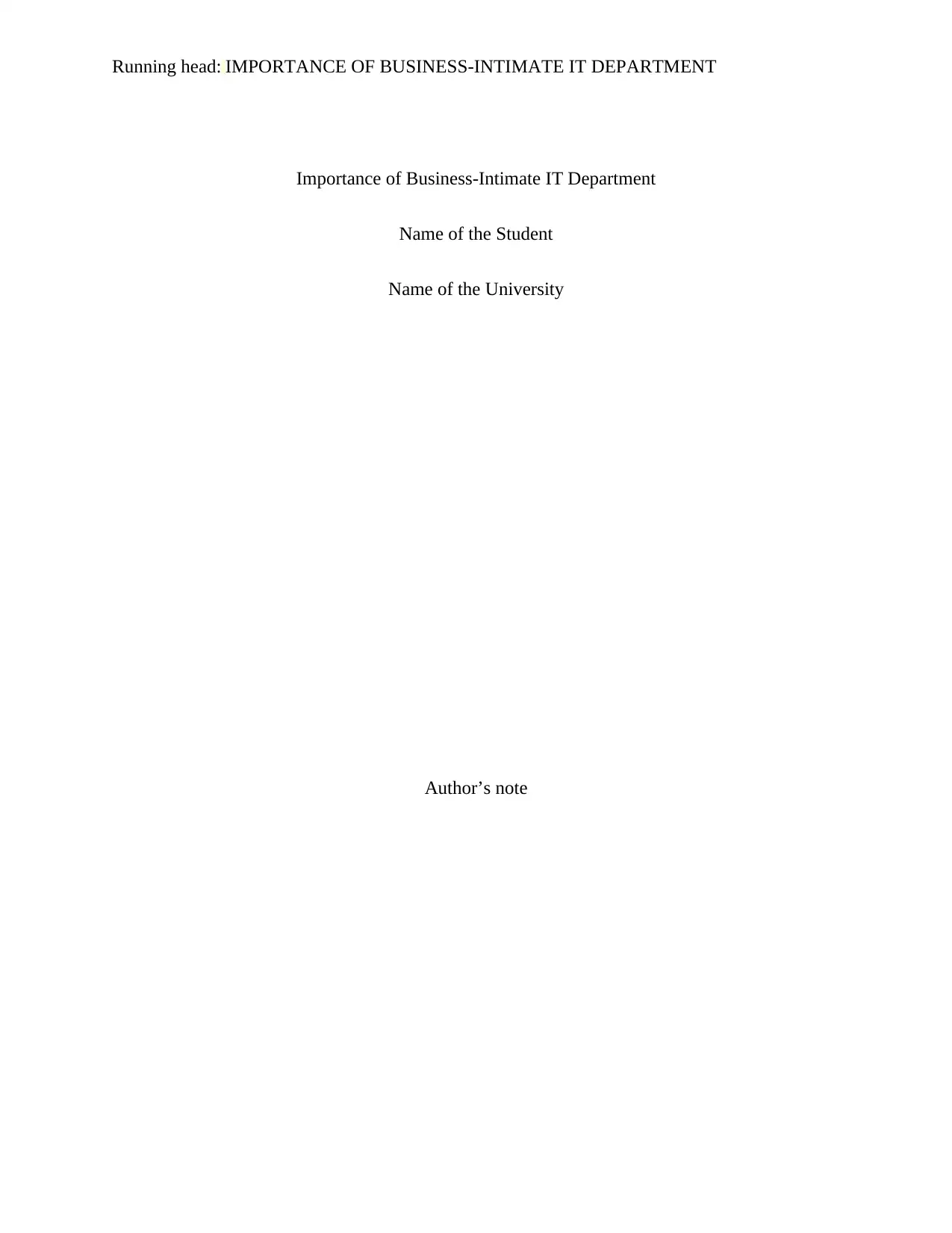
Running head: IMPORTANCE OF BUSINESS-INTIMATE IT DEPARTMENT
Importance of Business-Intimate IT Department
Name of the Student
Name of the University
Author’s note
Importance of Business-Intimate IT Department
Name of the Student
Name of the University
Author’s note
Paraphrase This Document
Need a fresh take? Get an instant paraphrase of this document with our AI Paraphraser
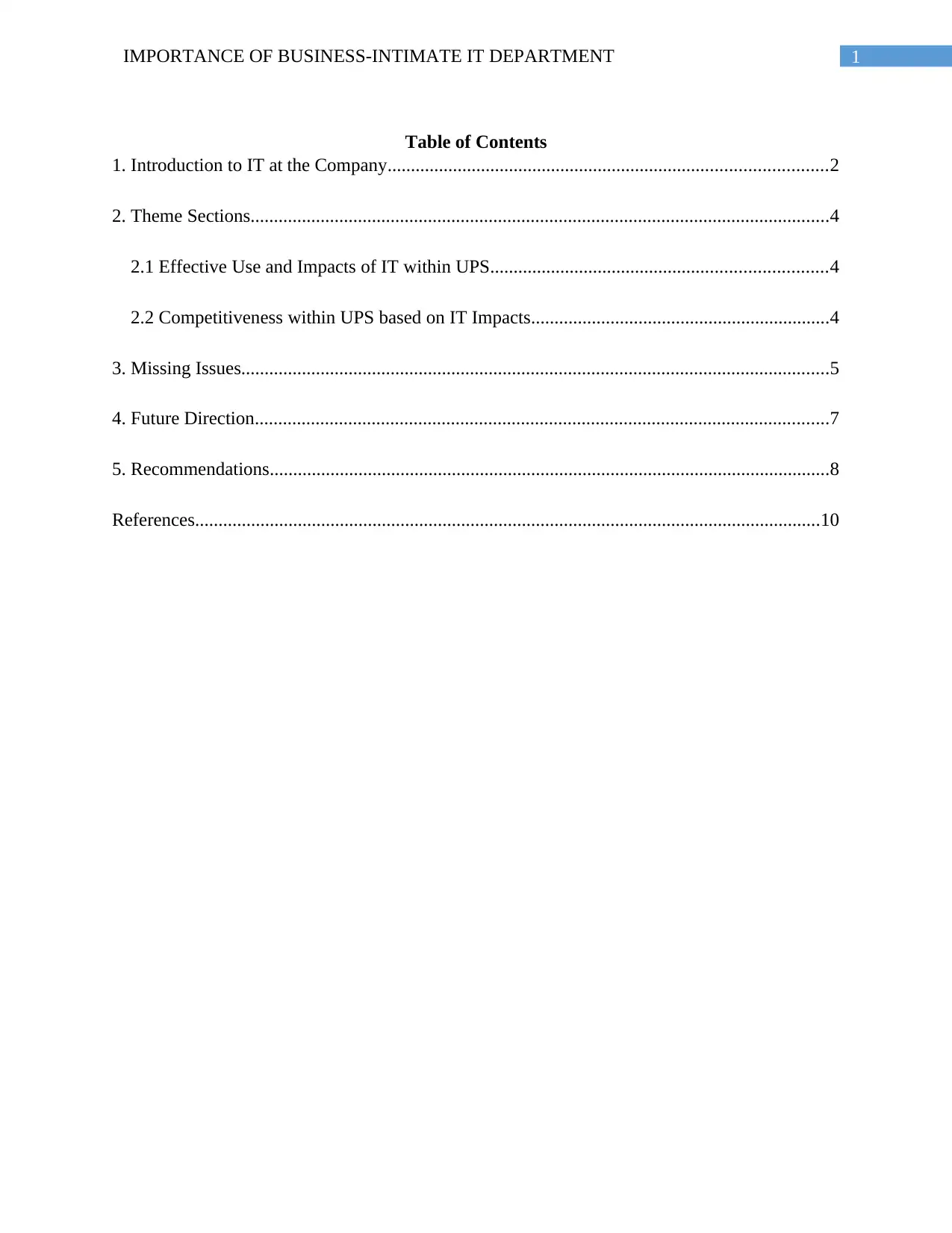
1IMPORTANCE OF BUSINESS-INTIMATE IT DEPARTMENT
Table of Contents
1. Introduction to IT at the Company..............................................................................................2
2. Theme Sections............................................................................................................................4
2.1 Effective Use and Impacts of IT within UPS........................................................................4
2.2 Competitiveness within UPS based on IT Impacts................................................................4
3. Missing Issues..............................................................................................................................5
4. Future Direction...........................................................................................................................7
5. Recommendations........................................................................................................................8
References......................................................................................................................................10
Table of Contents
1. Introduction to IT at the Company..............................................................................................2
2. Theme Sections............................................................................................................................4
2.1 Effective Use and Impacts of IT within UPS........................................................................4
2.2 Competitiveness within UPS based on IT Impacts................................................................4
3. Missing Issues..............................................................................................................................5
4. Future Direction...........................................................................................................................7
5. Recommendations........................................................................................................................8
References......................................................................................................................................10
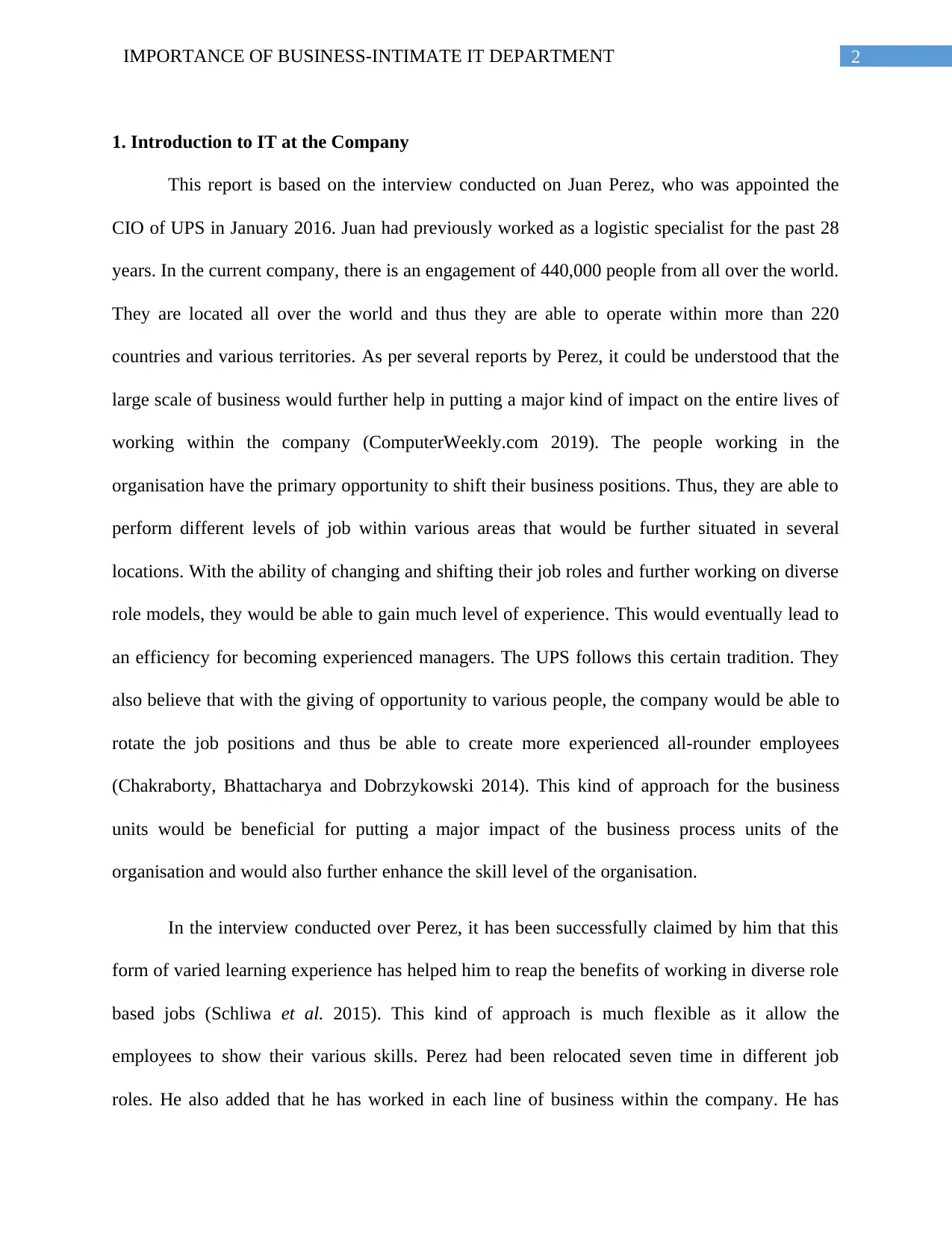
2IMPORTANCE OF BUSINESS-INTIMATE IT DEPARTMENT
1. Introduction to IT at the Company
This report is based on the interview conducted on Juan Perez, who was appointed the
CIO of UPS in January 2016. Juan had previously worked as a logistic specialist for the past 28
years. In the current company, there is an engagement of 440,000 people from all over the world.
They are located all over the world and thus they are able to operate within more than 220
countries and various territories. As per several reports by Perez, it could be understood that the
large scale of business would further help in putting a major kind of impact on the entire lives of
working within the company (ComputerWeekly.com 2019). The people working in the
organisation have the primary opportunity to shift their business positions. Thus, they are able to
perform different levels of job within various areas that would be further situated in several
locations. With the ability of changing and shifting their job roles and further working on diverse
role models, they would be able to gain much level of experience. This would eventually lead to
an efficiency for becoming experienced managers. The UPS follows this certain tradition. They
also believe that with the giving of opportunity to various people, the company would be able to
rotate the job positions and thus be able to create more experienced all-rounder employees
(Chakraborty, Bhattacharya and Dobrzykowski 2014). This kind of approach for the business
units would be beneficial for putting a major impact of the business process units of the
organisation and would also further enhance the skill level of the organisation.
In the interview conducted over Perez, it has been successfully claimed by him that this
form of varied learning experience has helped him to reap the benefits of working in diverse role
based jobs (Schliwa et al. 2015). This kind of approach is much flexible as it allow the
employees to show their various skills. Perez had been relocated seven time in different job
roles. He also added that he has worked in each line of business within the company. He has
1. Introduction to IT at the Company
This report is based on the interview conducted on Juan Perez, who was appointed the
CIO of UPS in January 2016. Juan had previously worked as a logistic specialist for the past 28
years. In the current company, there is an engagement of 440,000 people from all over the world.
They are located all over the world and thus they are able to operate within more than 220
countries and various territories. As per several reports by Perez, it could be understood that the
large scale of business would further help in putting a major kind of impact on the entire lives of
working within the company (ComputerWeekly.com 2019). The people working in the
organisation have the primary opportunity to shift their business positions. Thus, they are able to
perform different levels of job within various areas that would be further situated in several
locations. With the ability of changing and shifting their job roles and further working on diverse
role models, they would be able to gain much level of experience. This would eventually lead to
an efficiency for becoming experienced managers. The UPS follows this certain tradition. They
also believe that with the giving of opportunity to various people, the company would be able to
rotate the job positions and thus be able to create more experienced all-rounder employees
(Chakraborty, Bhattacharya and Dobrzykowski 2014). This kind of approach for the business
units would be beneficial for putting a major impact of the business process units of the
organisation and would also further enhance the skill level of the organisation.
In the interview conducted over Perez, it has been successfully claimed by him that this
form of varied learning experience has helped him to reap the benefits of working in diverse role
based jobs (Schliwa et al. 2015). This kind of approach is much flexible as it allow the
employees to show their various skills. Perez had been relocated seven time in different job
roles. He also added that he has worked in each line of business within the company. He has
⊘ This is a preview!⊘
Do you want full access?
Subscribe today to unlock all pages.

Trusted by 1+ million students worldwide
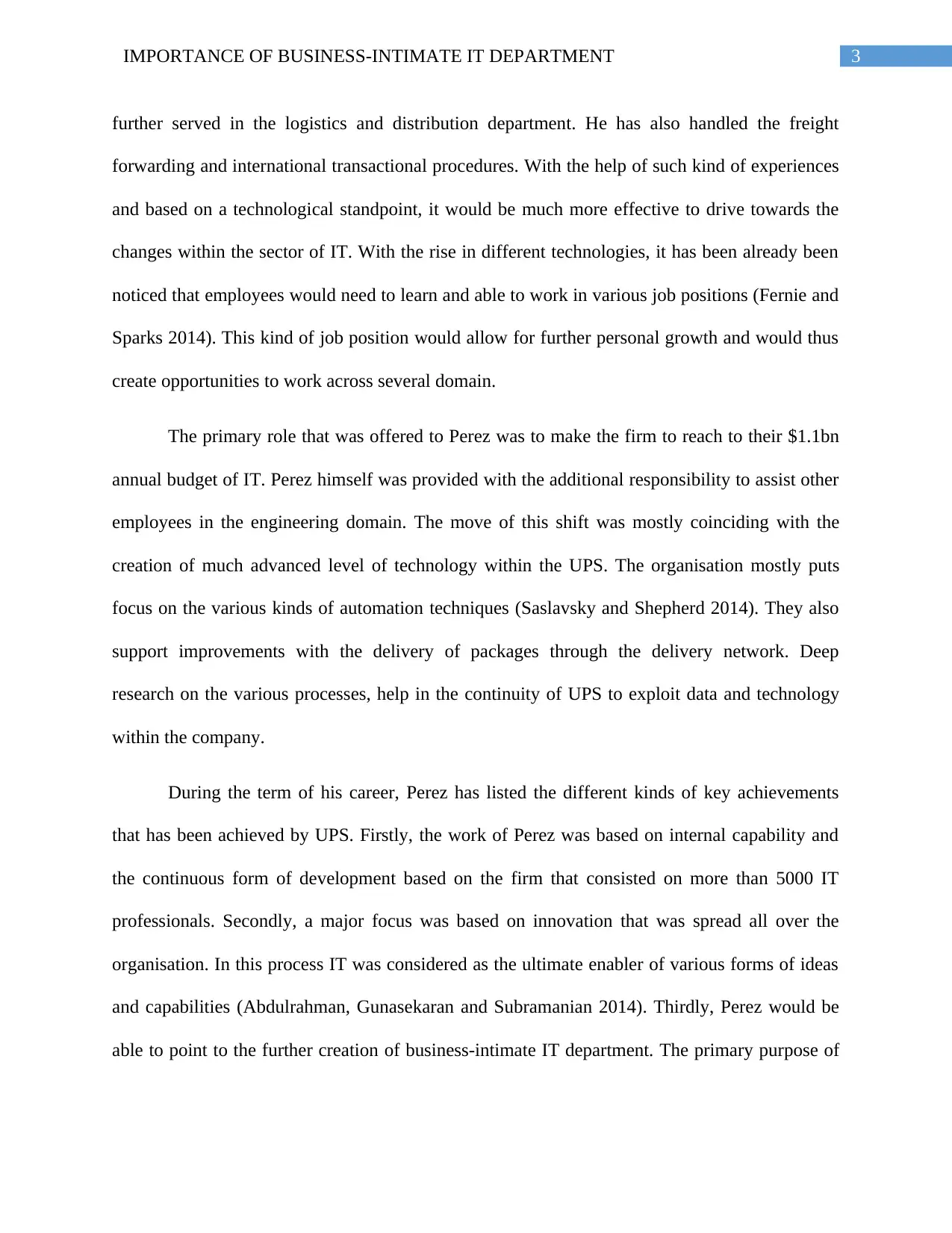
3IMPORTANCE OF BUSINESS-INTIMATE IT DEPARTMENT
further served in the logistics and distribution department. He has also handled the freight
forwarding and international transactional procedures. With the help of such kind of experiences
and based on a technological standpoint, it would be much more effective to drive towards the
changes within the sector of IT. With the rise in different technologies, it has been already been
noticed that employees would need to learn and able to work in various job positions (Fernie and
Sparks 2014). This kind of job position would allow for further personal growth and would thus
create opportunities to work across several domain.
The primary role that was offered to Perez was to make the firm to reach to their $1.1bn
annual budget of IT. Perez himself was provided with the additional responsibility to assist other
employees in the engineering domain. The move of this shift was mostly coinciding with the
creation of much advanced level of technology within the UPS. The organisation mostly puts
focus on the various kinds of automation techniques (Saslavsky and Shepherd 2014). They also
support improvements with the delivery of packages through the delivery network. Deep
research on the various processes, help in the continuity of UPS to exploit data and technology
within the company.
During the term of his career, Perez has listed the different kinds of key achievements
that has been achieved by UPS. Firstly, the work of Perez was based on internal capability and
the continuous form of development based on the firm that consisted on more than 5000 IT
professionals. Secondly, a major focus was based on innovation that was spread all over the
organisation. In this process IT was considered as the ultimate enabler of various forms of ideas
and capabilities (Abdulrahman, Gunasekaran and Subramanian 2014). Thirdly, Perez would be
able to point to the further creation of business-intimate IT department. The primary purpose of
further served in the logistics and distribution department. He has also handled the freight
forwarding and international transactional procedures. With the help of such kind of experiences
and based on a technological standpoint, it would be much more effective to drive towards the
changes within the sector of IT. With the rise in different technologies, it has been already been
noticed that employees would need to learn and able to work in various job positions (Fernie and
Sparks 2014). This kind of job position would allow for further personal growth and would thus
create opportunities to work across several domain.
The primary role that was offered to Perez was to make the firm to reach to their $1.1bn
annual budget of IT. Perez himself was provided with the additional responsibility to assist other
employees in the engineering domain. The move of this shift was mostly coinciding with the
creation of much advanced level of technology within the UPS. The organisation mostly puts
focus on the various kinds of automation techniques (Saslavsky and Shepherd 2014). They also
support improvements with the delivery of packages through the delivery network. Deep
research on the various processes, help in the continuity of UPS to exploit data and technology
within the company.
During the term of his career, Perez has listed the different kinds of key achievements
that has been achieved by UPS. Firstly, the work of Perez was based on internal capability and
the continuous form of development based on the firm that consisted on more than 5000 IT
professionals. Secondly, a major focus was based on innovation that was spread all over the
organisation. In this process IT was considered as the ultimate enabler of various forms of ideas
and capabilities (Abdulrahman, Gunasekaran and Subramanian 2014). Thirdly, Perez would be
able to point to the further creation of business-intimate IT department. The primary purpose of
Paraphrase This Document
Need a fresh take? Get an instant paraphrase of this document with our AI Paraphraser
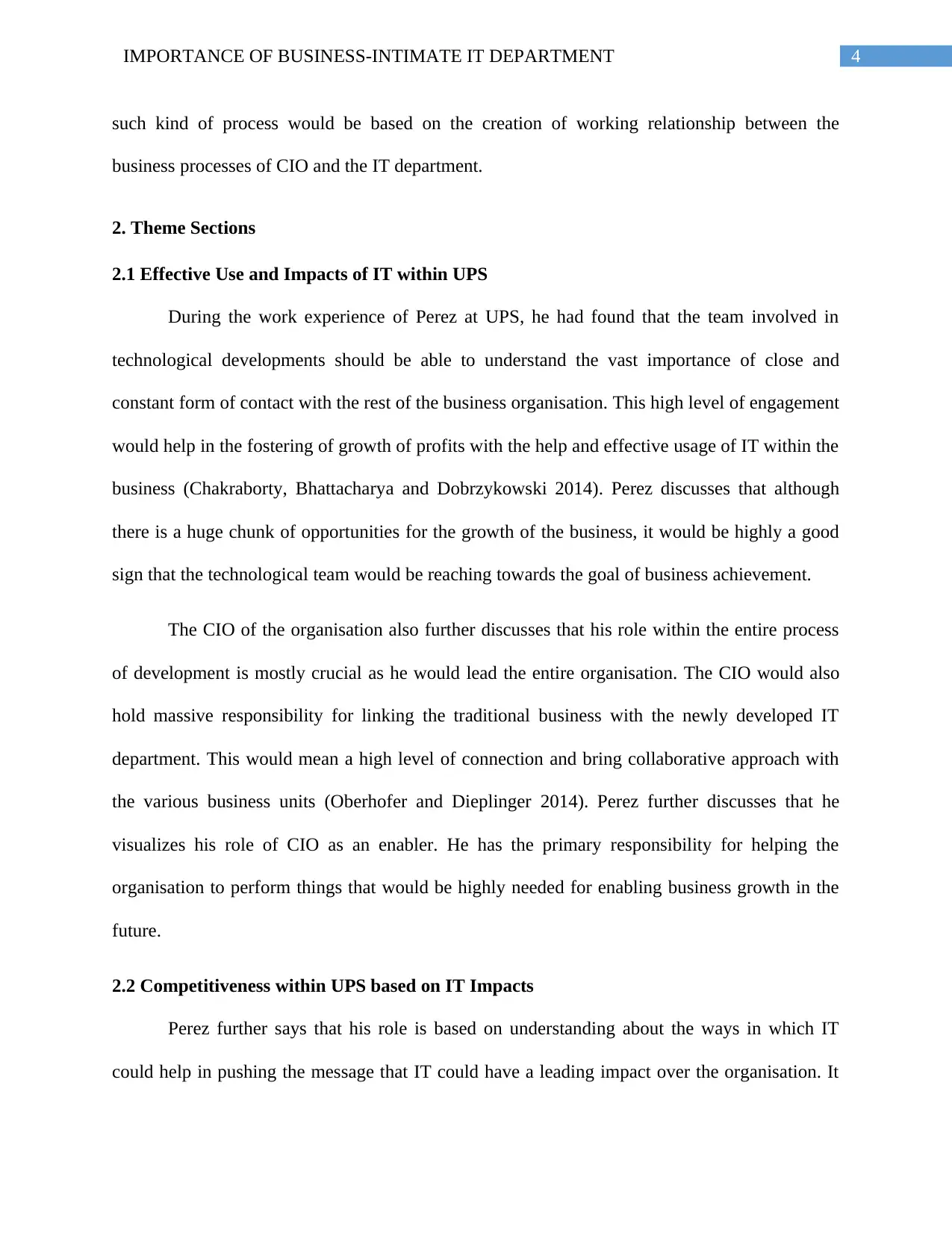
4IMPORTANCE OF BUSINESS-INTIMATE IT DEPARTMENT
such kind of process would be based on the creation of working relationship between the
business processes of CIO and the IT department.
2. Theme Sections
2.1 Effective Use and Impacts of IT within UPS
During the work experience of Perez at UPS, he had found that the team involved in
technological developments should be able to understand the vast importance of close and
constant form of contact with the rest of the business organisation. This high level of engagement
would help in the fostering of growth of profits with the help and effective usage of IT within the
business (Chakraborty, Bhattacharya and Dobrzykowski 2014). Perez discusses that although
there is a huge chunk of opportunities for the growth of the business, it would be highly a good
sign that the technological team would be reaching towards the goal of business achievement.
The CIO of the organisation also further discusses that his role within the entire process
of development is mostly crucial as he would lead the entire organisation. The CIO would also
hold massive responsibility for linking the traditional business with the newly developed IT
department. This would mean a high level of connection and bring collaborative approach with
the various business units (Oberhofer and Dieplinger 2014). Perez further discusses that he
visualizes his role of CIO as an enabler. He has the primary responsibility for helping the
organisation to perform things that would be highly needed for enabling business growth in the
future.
2.2 Competitiveness within UPS based on IT Impacts
Perez further says that his role is based on understanding about the ways in which IT
could help in pushing the message that IT could have a leading impact over the organisation. It
such kind of process would be based on the creation of working relationship between the
business processes of CIO and the IT department.
2. Theme Sections
2.1 Effective Use and Impacts of IT within UPS
During the work experience of Perez at UPS, he had found that the team involved in
technological developments should be able to understand the vast importance of close and
constant form of contact with the rest of the business organisation. This high level of engagement
would help in the fostering of growth of profits with the help and effective usage of IT within the
business (Chakraborty, Bhattacharya and Dobrzykowski 2014). Perez discusses that although
there is a huge chunk of opportunities for the growth of the business, it would be highly a good
sign that the technological team would be reaching towards the goal of business achievement.
The CIO of the organisation also further discusses that his role within the entire process
of development is mostly crucial as he would lead the entire organisation. The CIO would also
hold massive responsibility for linking the traditional business with the newly developed IT
department. This would mean a high level of connection and bring collaborative approach with
the various business units (Oberhofer and Dieplinger 2014). Perez further discusses that he
visualizes his role of CIO as an enabler. He has the primary responsibility for helping the
organisation to perform things that would be highly needed for enabling business growth in the
future.
2.2 Competitiveness within UPS based on IT Impacts
Perez further says that his role is based on understanding about the ways in which IT
could help in pushing the message that IT could have a leading impact over the organisation. It
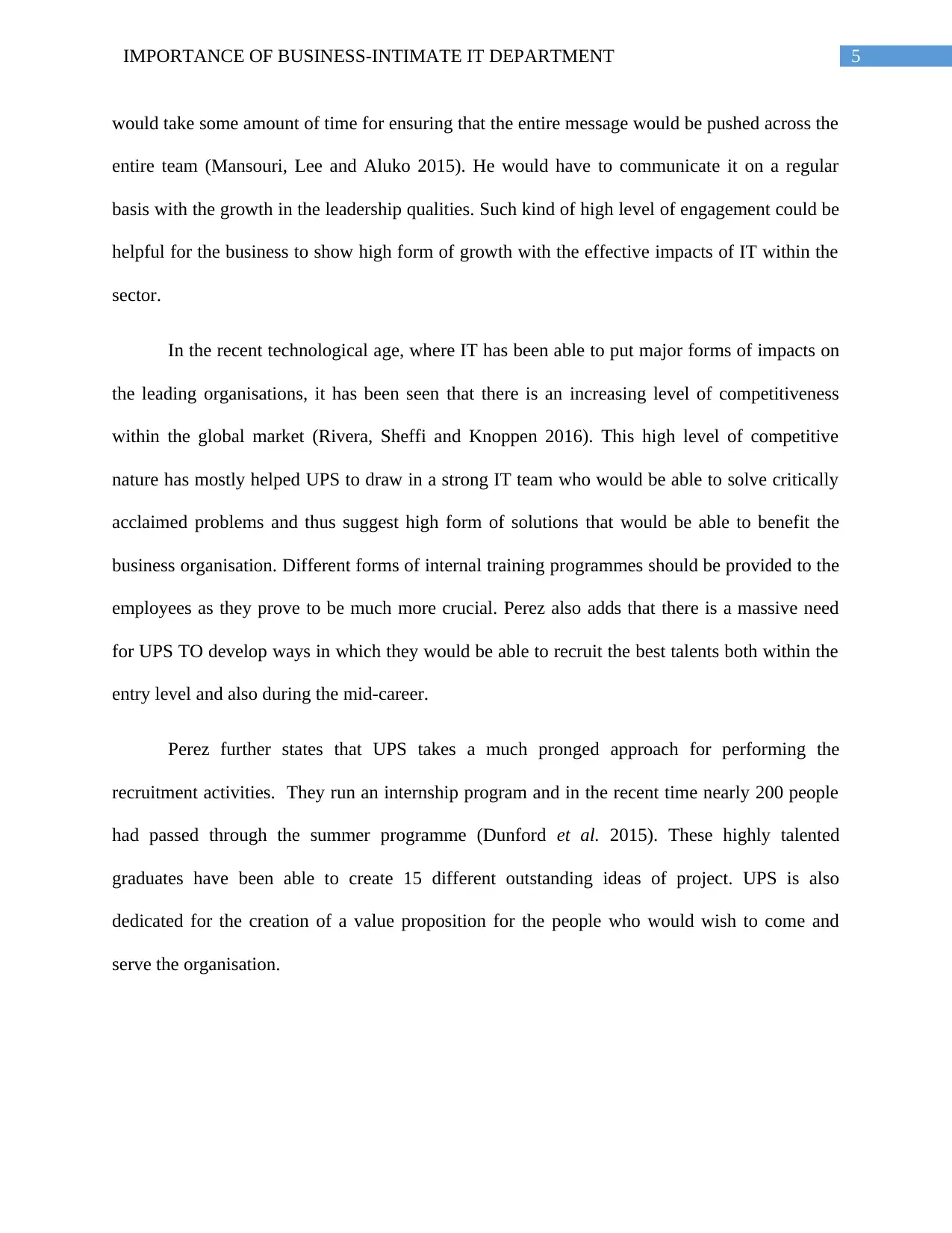
5IMPORTANCE OF BUSINESS-INTIMATE IT DEPARTMENT
would take some amount of time for ensuring that the entire message would be pushed across the
entire team (Mansouri, Lee and Aluko 2015). He would have to communicate it on a regular
basis with the growth in the leadership qualities. Such kind of high level of engagement could be
helpful for the business to show high form of growth with the effective impacts of IT within the
sector.
In the recent technological age, where IT has been able to put major forms of impacts on
the leading organisations, it has been seen that there is an increasing level of competitiveness
within the global market (Rivera, Sheffi and Knoppen 2016). This high level of competitive
nature has mostly helped UPS to draw in a strong IT team who would be able to solve critically
acclaimed problems and thus suggest high form of solutions that would be able to benefit the
business organisation. Different forms of internal training programmes should be provided to the
employees as they prove to be much more crucial. Perez also adds that there is a massive need
for UPS TO develop ways in which they would be able to recruit the best talents both within the
entry level and also during the mid-career.
Perez further states that UPS takes a much pronged approach for performing the
recruitment activities. They run an internship program and in the recent time nearly 200 people
had passed through the summer programme (Dunford et al. 2015). These highly talented
graduates have been able to create 15 different outstanding ideas of project. UPS is also
dedicated for the creation of a value proposition for the people who would wish to come and
serve the organisation.
would take some amount of time for ensuring that the entire message would be pushed across the
entire team (Mansouri, Lee and Aluko 2015). He would have to communicate it on a regular
basis with the growth in the leadership qualities. Such kind of high level of engagement could be
helpful for the business to show high form of growth with the effective impacts of IT within the
sector.
In the recent technological age, where IT has been able to put major forms of impacts on
the leading organisations, it has been seen that there is an increasing level of competitiveness
within the global market (Rivera, Sheffi and Knoppen 2016). This high level of competitive
nature has mostly helped UPS to draw in a strong IT team who would be able to solve critically
acclaimed problems and thus suggest high form of solutions that would be able to benefit the
business organisation. Different forms of internal training programmes should be provided to the
employees as they prove to be much more crucial. Perez also adds that there is a massive need
for UPS TO develop ways in which they would be able to recruit the best talents both within the
entry level and also during the mid-career.
Perez further states that UPS takes a much pronged approach for performing the
recruitment activities. They run an internship program and in the recent time nearly 200 people
had passed through the summer programme (Dunford et al. 2015). These highly talented
graduates have been able to create 15 different outstanding ideas of project. UPS is also
dedicated for the creation of a value proposition for the people who would wish to come and
serve the organisation.
⊘ This is a preview!⊘
Do you want full access?
Subscribe today to unlock all pages.

Trusted by 1+ million students worldwide
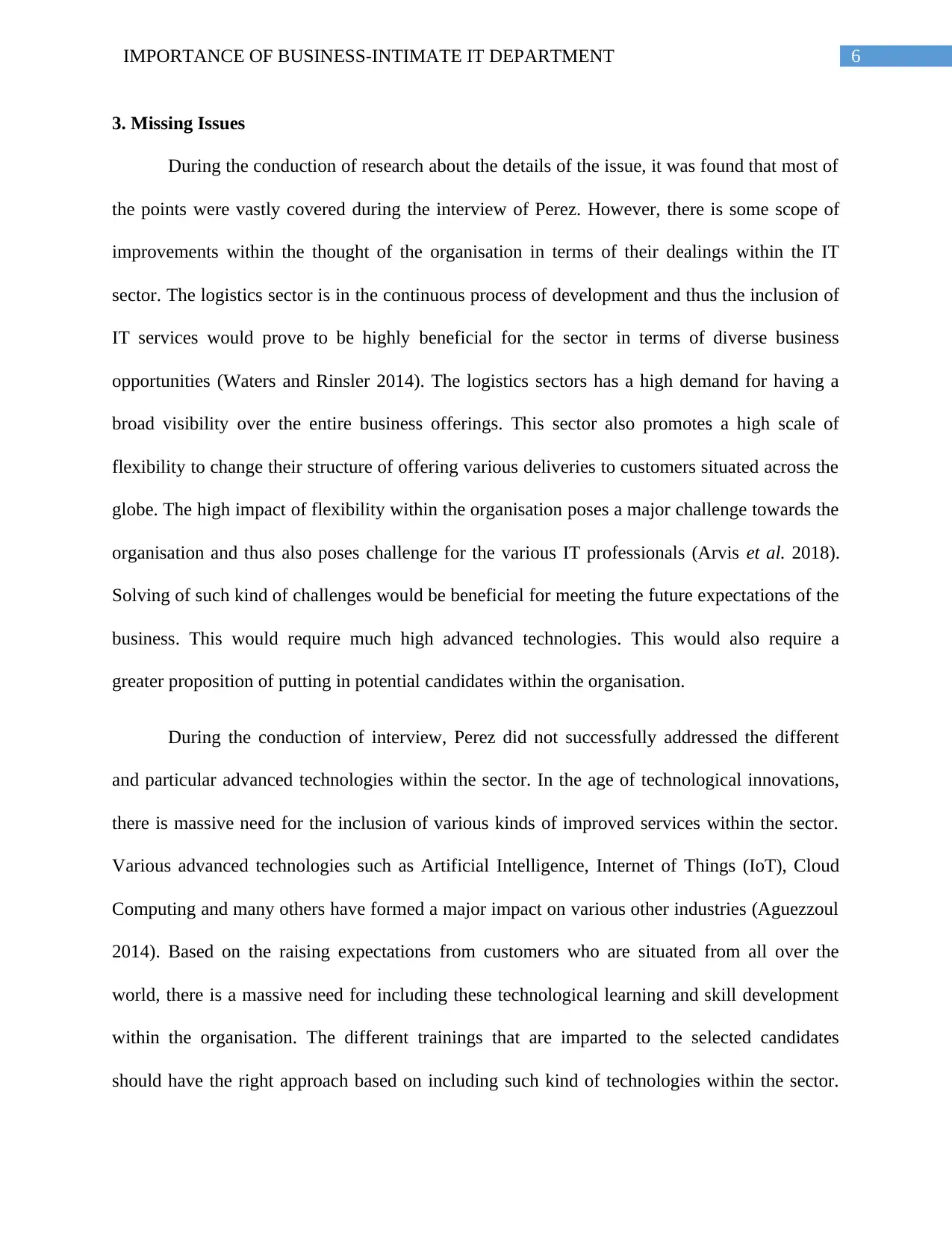
6IMPORTANCE OF BUSINESS-INTIMATE IT DEPARTMENT
3. Missing Issues
During the conduction of research about the details of the issue, it was found that most of
the points were vastly covered during the interview of Perez. However, there is some scope of
improvements within the thought of the organisation in terms of their dealings within the IT
sector. The logistics sector is in the continuous process of development and thus the inclusion of
IT services would prove to be highly beneficial for the sector in terms of diverse business
opportunities (Waters and Rinsler 2014). The logistics sectors has a high demand for having a
broad visibility over the entire business offerings. This sector also promotes a high scale of
flexibility to change their structure of offering various deliveries to customers situated across the
globe. The high impact of flexibility within the organisation poses a major challenge towards the
organisation and thus also poses challenge for the various IT professionals (Arvis et al. 2018).
Solving of such kind of challenges would be beneficial for meeting the future expectations of the
business. This would require much high advanced technologies. This would also require a
greater proposition of putting in potential candidates within the organisation.
During the conduction of interview, Perez did not successfully addressed the different
and particular advanced technologies within the sector. In the age of technological innovations,
there is massive need for the inclusion of various kinds of improved services within the sector.
Various advanced technologies such as Artificial Intelligence, Internet of Things (IoT), Cloud
Computing and many others have formed a major impact on various other industries (Aguezzoul
2014). Based on the raising expectations from customers who are situated from all over the
world, there is a massive need for including these technological learning and skill development
within the organisation. The different trainings that are imparted to the selected candidates
should have the right approach based on including such kind of technologies within the sector.
3. Missing Issues
During the conduction of research about the details of the issue, it was found that most of
the points were vastly covered during the interview of Perez. However, there is some scope of
improvements within the thought of the organisation in terms of their dealings within the IT
sector. The logistics sector is in the continuous process of development and thus the inclusion of
IT services would prove to be highly beneficial for the sector in terms of diverse business
opportunities (Waters and Rinsler 2014). The logistics sectors has a high demand for having a
broad visibility over the entire business offerings. This sector also promotes a high scale of
flexibility to change their structure of offering various deliveries to customers situated across the
globe. The high impact of flexibility within the organisation poses a major challenge towards the
organisation and thus also poses challenge for the various IT professionals (Arvis et al. 2018).
Solving of such kind of challenges would be beneficial for meeting the future expectations of the
business. This would require much high advanced technologies. This would also require a
greater proposition of putting in potential candidates within the organisation.
During the conduction of interview, Perez did not successfully addressed the different
and particular advanced technologies within the sector. In the age of technological innovations,
there is massive need for the inclusion of various kinds of improved services within the sector.
Various advanced technologies such as Artificial Intelligence, Internet of Things (IoT), Cloud
Computing and many others have formed a major impact on various other industries (Aguezzoul
2014). Based on the raising expectations from customers who are situated from all over the
world, there is a massive need for including these technological learning and skill development
within the organisation. The different trainings that are imparted to the selected candidates
should have the right approach based on including such kind of technologies within the sector.
Paraphrase This Document
Need a fresh take? Get an instant paraphrase of this document with our AI Paraphraser
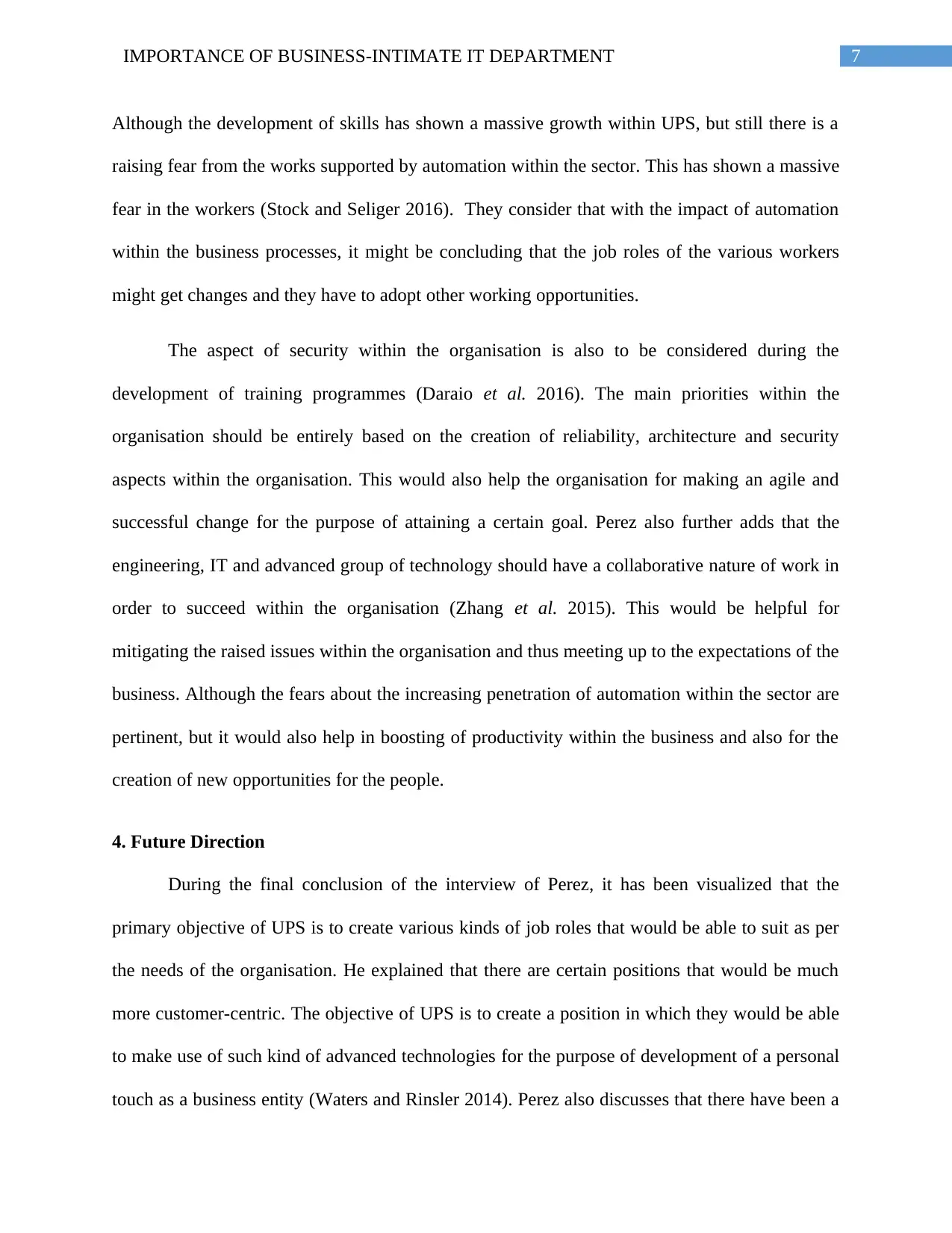
7IMPORTANCE OF BUSINESS-INTIMATE IT DEPARTMENT
Although the development of skills has shown a massive growth within UPS, but still there is a
raising fear from the works supported by automation within the sector. This has shown a massive
fear in the workers (Stock and Seliger 2016). They consider that with the impact of automation
within the business processes, it might be concluding that the job roles of the various workers
might get changes and they have to adopt other working opportunities.
The aspect of security within the organisation is also to be considered during the
development of training programmes (Daraio et al. 2016). The main priorities within the
organisation should be entirely based on the creation of reliability, architecture and security
aspects within the organisation. This would also help the organisation for making an agile and
successful change for the purpose of attaining a certain goal. Perez also further adds that the
engineering, IT and advanced group of technology should have a collaborative nature of work in
order to succeed within the organisation (Zhang et al. 2015). This would be helpful for
mitigating the raised issues within the organisation and thus meeting up to the expectations of the
business. Although the fears about the increasing penetration of automation within the sector are
pertinent, but it would also help in boosting of productivity within the business and also for the
creation of new opportunities for the people.
4. Future Direction
During the final conclusion of the interview of Perez, it has been visualized that the
primary objective of UPS is to create various kinds of job roles that would be able to suit as per
the needs of the organisation. He explained that there are certain positions that would be much
more customer-centric. The objective of UPS is to create a position in which they would be able
to make use of such kind of advanced technologies for the purpose of development of a personal
touch as a business entity (Waters and Rinsler 2014). Perez also discusses that there have been a
Although the development of skills has shown a massive growth within UPS, but still there is a
raising fear from the works supported by automation within the sector. This has shown a massive
fear in the workers (Stock and Seliger 2016). They consider that with the impact of automation
within the business processes, it might be concluding that the job roles of the various workers
might get changes and they have to adopt other working opportunities.
The aspect of security within the organisation is also to be considered during the
development of training programmes (Daraio et al. 2016). The main priorities within the
organisation should be entirely based on the creation of reliability, architecture and security
aspects within the organisation. This would also help the organisation for making an agile and
successful change for the purpose of attaining a certain goal. Perez also further adds that the
engineering, IT and advanced group of technology should have a collaborative nature of work in
order to succeed within the organisation (Zhang et al. 2015). This would be helpful for
mitigating the raised issues within the organisation and thus meeting up to the expectations of the
business. Although the fears about the increasing penetration of automation within the sector are
pertinent, but it would also help in boosting of productivity within the business and also for the
creation of new opportunities for the people.
4. Future Direction
During the final conclusion of the interview of Perez, it has been visualized that the
primary objective of UPS is to create various kinds of job roles that would be able to suit as per
the needs of the organisation. He explained that there are certain positions that would be much
more customer-centric. The objective of UPS is to create a position in which they would be able
to make use of such kind of advanced technologies for the purpose of development of a personal
touch as a business entity (Waters and Rinsler 2014). Perez also discusses that there have been a
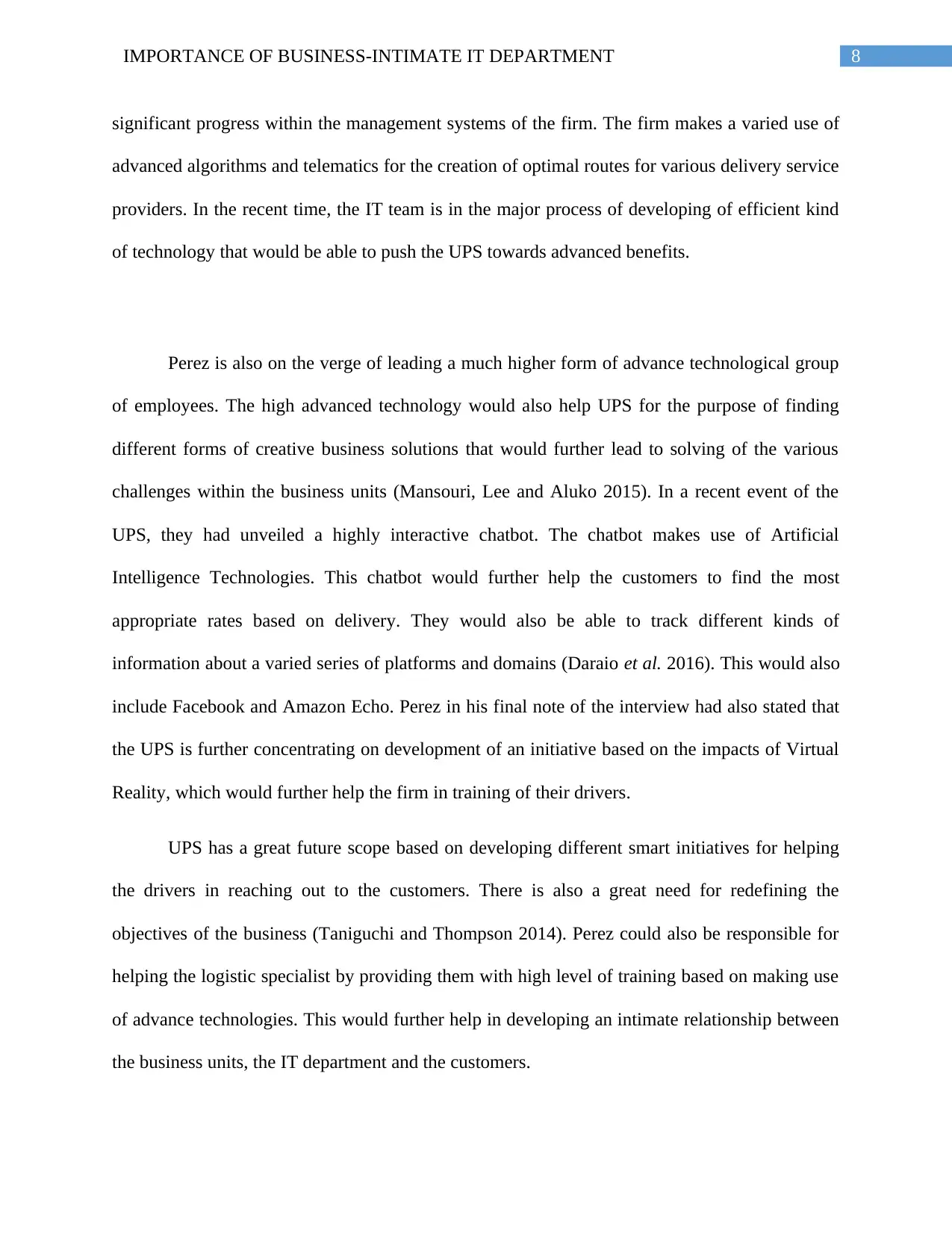
8IMPORTANCE OF BUSINESS-INTIMATE IT DEPARTMENT
significant progress within the management systems of the firm. The firm makes a varied use of
advanced algorithms and telematics for the creation of optimal routes for various delivery service
providers. In the recent time, the IT team is in the major process of developing of efficient kind
of technology that would be able to push the UPS towards advanced benefits.
Perez is also on the verge of leading a much higher form of advance technological group
of employees. The high advanced technology would also help UPS for the purpose of finding
different forms of creative business solutions that would further lead to solving of the various
challenges within the business units (Mansouri, Lee and Aluko 2015). In a recent event of the
UPS, they had unveiled a highly interactive chatbot. The chatbot makes use of Artificial
Intelligence Technologies. This chatbot would further help the customers to find the most
appropriate rates based on delivery. They would also be able to track different kinds of
information about a varied series of platforms and domains (Daraio et al. 2016). This would also
include Facebook and Amazon Echo. Perez in his final note of the interview had also stated that
the UPS is further concentrating on development of an initiative based on the impacts of Virtual
Reality, which would further help the firm in training of their drivers.
UPS has a great future scope based on developing different smart initiatives for helping
the drivers in reaching out to the customers. There is also a great need for redefining the
objectives of the business (Taniguchi and Thompson 2014). Perez could also be responsible for
helping the logistic specialist by providing them with high level of training based on making use
of advance technologies. This would further help in developing an intimate relationship between
the business units, the IT department and the customers.
significant progress within the management systems of the firm. The firm makes a varied use of
advanced algorithms and telematics for the creation of optimal routes for various delivery service
providers. In the recent time, the IT team is in the major process of developing of efficient kind
of technology that would be able to push the UPS towards advanced benefits.
Perez is also on the verge of leading a much higher form of advance technological group
of employees. The high advanced technology would also help UPS for the purpose of finding
different forms of creative business solutions that would further lead to solving of the various
challenges within the business units (Mansouri, Lee and Aluko 2015). In a recent event of the
UPS, they had unveiled a highly interactive chatbot. The chatbot makes use of Artificial
Intelligence Technologies. This chatbot would further help the customers to find the most
appropriate rates based on delivery. They would also be able to track different kinds of
information about a varied series of platforms and domains (Daraio et al. 2016). This would also
include Facebook and Amazon Echo. Perez in his final note of the interview had also stated that
the UPS is further concentrating on development of an initiative based on the impacts of Virtual
Reality, which would further help the firm in training of their drivers.
UPS has a great future scope based on developing different smart initiatives for helping
the drivers in reaching out to the customers. There is also a great need for redefining the
objectives of the business (Taniguchi and Thompson 2014). Perez could also be responsible for
helping the logistic specialist by providing them with high level of training based on making use
of advance technologies. This would further help in developing an intimate relationship between
the business units, the IT department and the customers.
⊘ This is a preview!⊘
Do you want full access?
Subscribe today to unlock all pages.

Trusted by 1+ million students worldwide
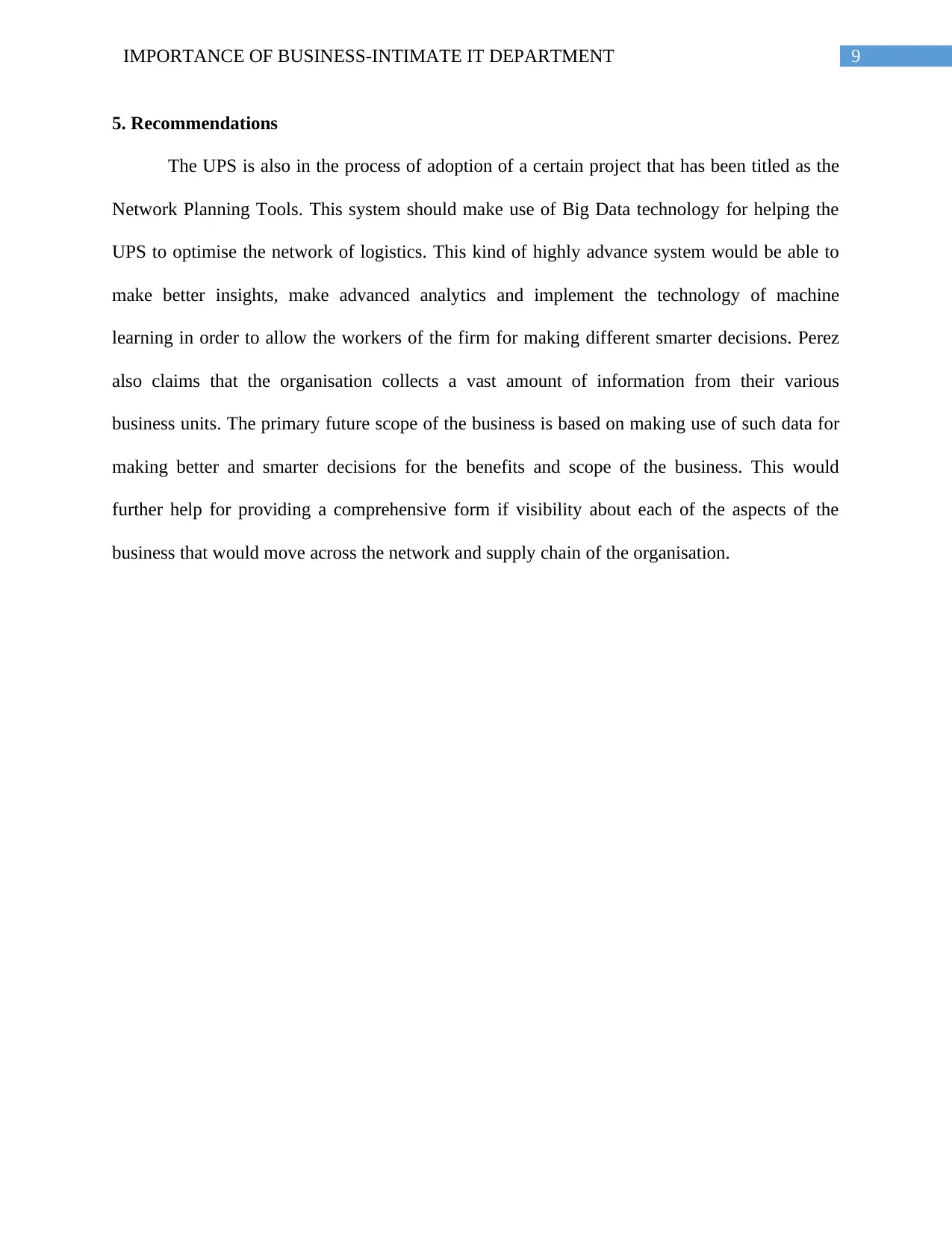
9IMPORTANCE OF BUSINESS-INTIMATE IT DEPARTMENT
5. Recommendations
The UPS is also in the process of adoption of a certain project that has been titled as the
Network Planning Tools. This system should make use of Big Data technology for helping the
UPS to optimise the network of logistics. This kind of highly advance system would be able to
make better insights, make advanced analytics and implement the technology of machine
learning in order to allow the workers of the firm for making different smarter decisions. Perez
also claims that the organisation collects a vast amount of information from their various
business units. The primary future scope of the business is based on making use of such data for
making better and smarter decisions for the benefits and scope of the business. This would
further help for providing a comprehensive form if visibility about each of the aspects of the
business that would move across the network and supply chain of the organisation.
5. Recommendations
The UPS is also in the process of adoption of a certain project that has been titled as the
Network Planning Tools. This system should make use of Big Data technology for helping the
UPS to optimise the network of logistics. This kind of highly advance system would be able to
make better insights, make advanced analytics and implement the technology of machine
learning in order to allow the workers of the firm for making different smarter decisions. Perez
also claims that the organisation collects a vast amount of information from their various
business units. The primary future scope of the business is based on making use of such data for
making better and smarter decisions for the benefits and scope of the business. This would
further help for providing a comprehensive form if visibility about each of the aspects of the
business that would move across the network and supply chain of the organisation.
Paraphrase This Document
Need a fresh take? Get an instant paraphrase of this document with our AI Paraphraser
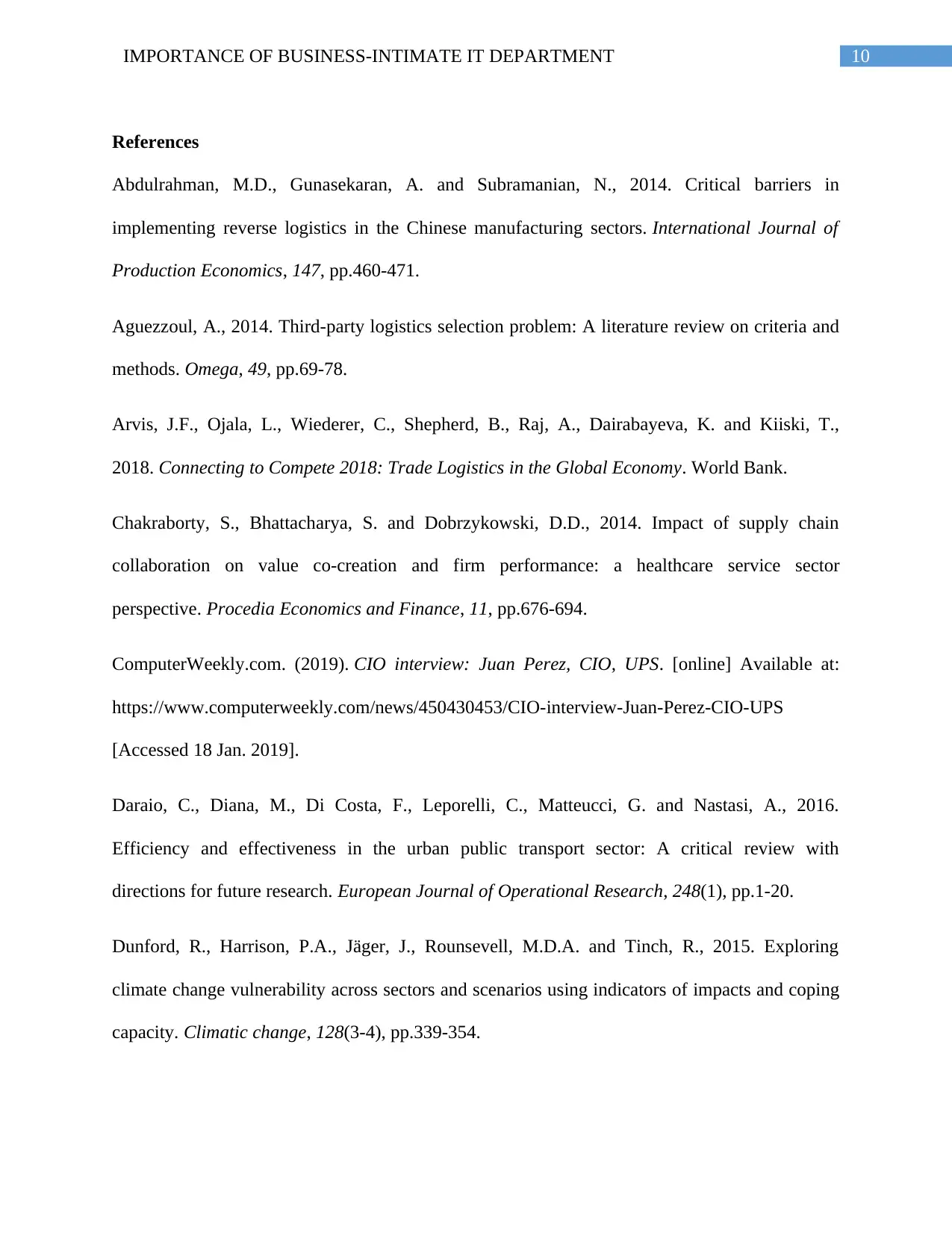
10IMPORTANCE OF BUSINESS-INTIMATE IT DEPARTMENT
References
Abdulrahman, M.D., Gunasekaran, A. and Subramanian, N., 2014. Critical barriers in
implementing reverse logistics in the Chinese manufacturing sectors. International Journal of
Production Economics, 147, pp.460-471.
Aguezzoul, A., 2014. Third-party logistics selection problem: A literature review on criteria and
methods. Omega, 49, pp.69-78.
Arvis, J.F., Ojala, L., Wiederer, C., Shepherd, B., Raj, A., Dairabayeva, K. and Kiiski, T.,
2018. Connecting to Compete 2018: Trade Logistics in the Global Economy. World Bank.
Chakraborty, S., Bhattacharya, S. and Dobrzykowski, D.D., 2014. Impact of supply chain
collaboration on value co-creation and firm performance: a healthcare service sector
perspective. Procedia Economics and Finance, 11, pp.676-694.
ComputerWeekly.com. (2019). CIO interview: Juan Perez, CIO, UPS. [online] Available at:
https://www.computerweekly.com/news/450430453/CIO-interview-Juan-Perez-CIO-UPS
[Accessed 18 Jan. 2019].
Daraio, C., Diana, M., Di Costa, F., Leporelli, C., Matteucci, G. and Nastasi, A., 2016.
Efficiency and effectiveness in the urban public transport sector: A critical review with
directions for future research. European Journal of Operational Research, 248(1), pp.1-20.
Dunford, R., Harrison, P.A., Jäger, J., Rounsevell, M.D.A. and Tinch, R., 2015. Exploring
climate change vulnerability across sectors and scenarios using indicators of impacts and coping
capacity. Climatic change, 128(3-4), pp.339-354.
References
Abdulrahman, M.D., Gunasekaran, A. and Subramanian, N., 2014. Critical barriers in
implementing reverse logistics in the Chinese manufacturing sectors. International Journal of
Production Economics, 147, pp.460-471.
Aguezzoul, A., 2014. Third-party logistics selection problem: A literature review on criteria and
methods. Omega, 49, pp.69-78.
Arvis, J.F., Ojala, L., Wiederer, C., Shepherd, B., Raj, A., Dairabayeva, K. and Kiiski, T.,
2018. Connecting to Compete 2018: Trade Logistics in the Global Economy. World Bank.
Chakraborty, S., Bhattacharya, S. and Dobrzykowski, D.D., 2014. Impact of supply chain
collaboration on value co-creation and firm performance: a healthcare service sector
perspective. Procedia Economics and Finance, 11, pp.676-694.
ComputerWeekly.com. (2019). CIO interview: Juan Perez, CIO, UPS. [online] Available at:
https://www.computerweekly.com/news/450430453/CIO-interview-Juan-Perez-CIO-UPS
[Accessed 18 Jan. 2019].
Daraio, C., Diana, M., Di Costa, F., Leporelli, C., Matteucci, G. and Nastasi, A., 2016.
Efficiency and effectiveness in the urban public transport sector: A critical review with
directions for future research. European Journal of Operational Research, 248(1), pp.1-20.
Dunford, R., Harrison, P.A., Jäger, J., Rounsevell, M.D.A. and Tinch, R., 2015. Exploring
climate change vulnerability across sectors and scenarios using indicators of impacts and coping
capacity. Climatic change, 128(3-4), pp.339-354.
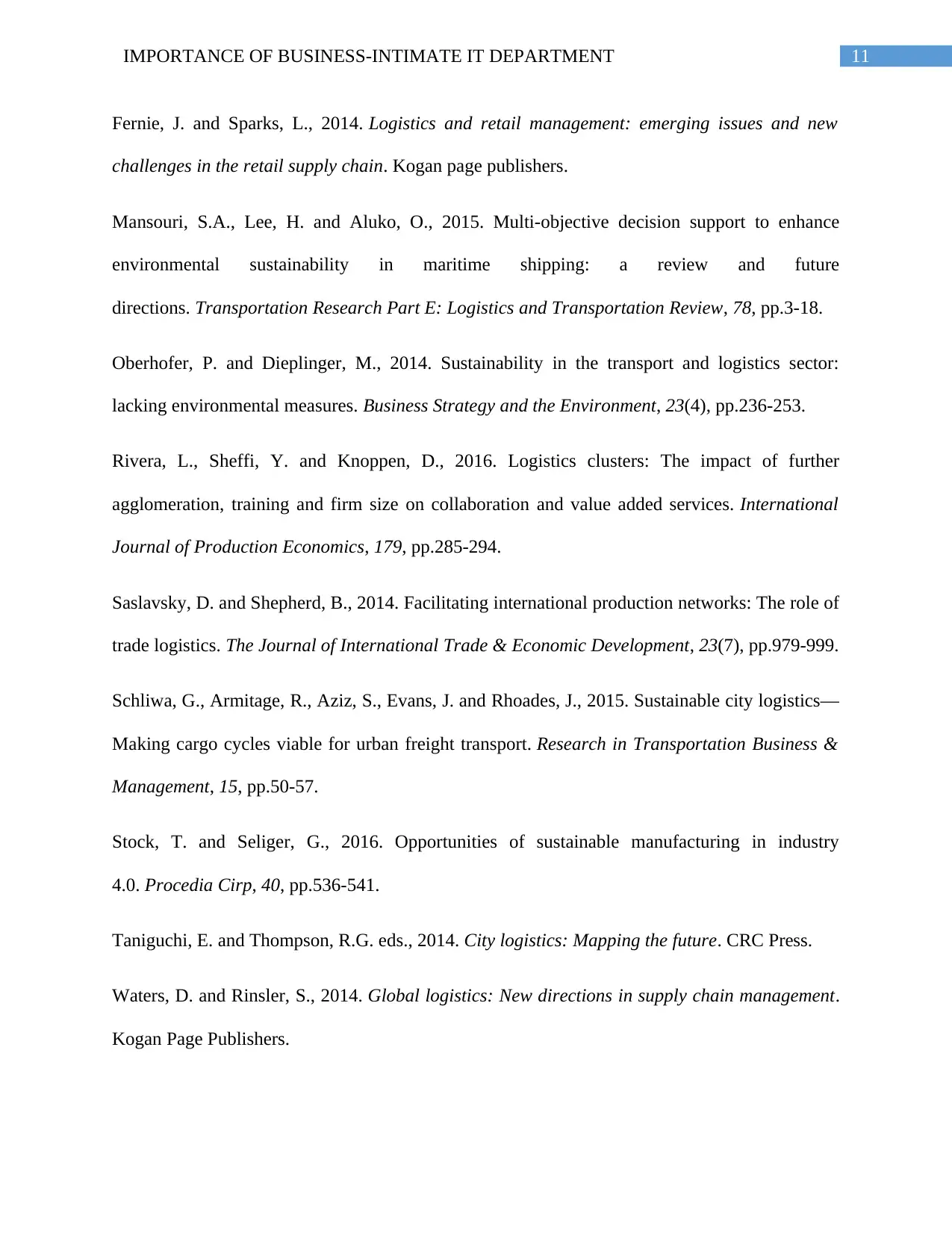
11IMPORTANCE OF BUSINESS-INTIMATE IT DEPARTMENT
Fernie, J. and Sparks, L., 2014. Logistics and retail management: emerging issues and new
challenges in the retail supply chain. Kogan page publishers.
Mansouri, S.A., Lee, H. and Aluko, O., 2015. Multi-objective decision support to enhance
environmental sustainability in maritime shipping: a review and future
directions. Transportation Research Part E: Logistics and Transportation Review, 78, pp.3-18.
Oberhofer, P. and Dieplinger, M., 2014. Sustainability in the transport and logistics sector:
lacking environmental measures. Business Strategy and the Environment, 23(4), pp.236-253.
Rivera, L., Sheffi, Y. and Knoppen, D., 2016. Logistics clusters: The impact of further
agglomeration, training and firm size on collaboration and value added services. International
Journal of Production Economics, 179, pp.285-294.
Saslavsky, D. and Shepherd, B., 2014. Facilitating international production networks: The role of
trade logistics. The Journal of International Trade & Economic Development, 23(7), pp.979-999.
Schliwa, G., Armitage, R., Aziz, S., Evans, J. and Rhoades, J., 2015. Sustainable city logistics—
Making cargo cycles viable for urban freight transport. Research in Transportation Business &
Management, 15, pp.50-57.
Stock, T. and Seliger, G., 2016. Opportunities of sustainable manufacturing in industry
4.0. Procedia Cirp, 40, pp.536-541.
Taniguchi, E. and Thompson, R.G. eds., 2014. City logistics: Mapping the future. CRC Press.
Waters, D. and Rinsler, S., 2014. Global logistics: New directions in supply chain management.
Kogan Page Publishers.
Fernie, J. and Sparks, L., 2014. Logistics and retail management: emerging issues and new
challenges in the retail supply chain. Kogan page publishers.
Mansouri, S.A., Lee, H. and Aluko, O., 2015. Multi-objective decision support to enhance
environmental sustainability in maritime shipping: a review and future
directions. Transportation Research Part E: Logistics and Transportation Review, 78, pp.3-18.
Oberhofer, P. and Dieplinger, M., 2014. Sustainability in the transport and logistics sector:
lacking environmental measures. Business Strategy and the Environment, 23(4), pp.236-253.
Rivera, L., Sheffi, Y. and Knoppen, D., 2016. Logistics clusters: The impact of further
agglomeration, training and firm size on collaboration and value added services. International
Journal of Production Economics, 179, pp.285-294.
Saslavsky, D. and Shepherd, B., 2014. Facilitating international production networks: The role of
trade logistics. The Journal of International Trade & Economic Development, 23(7), pp.979-999.
Schliwa, G., Armitage, R., Aziz, S., Evans, J. and Rhoades, J., 2015. Sustainable city logistics—
Making cargo cycles viable for urban freight transport. Research in Transportation Business &
Management, 15, pp.50-57.
Stock, T. and Seliger, G., 2016. Opportunities of sustainable manufacturing in industry
4.0. Procedia Cirp, 40, pp.536-541.
Taniguchi, E. and Thompson, R.G. eds., 2014. City logistics: Mapping the future. CRC Press.
Waters, D. and Rinsler, S., 2014. Global logistics: New directions in supply chain management.
Kogan Page Publishers.
⊘ This is a preview!⊘
Do you want full access?
Subscribe today to unlock all pages.

Trusted by 1+ million students worldwide
1 out of 13
Related Documents
Your All-in-One AI-Powered Toolkit for Academic Success.
+13062052269
info@desklib.com
Available 24*7 on WhatsApp / Email
![[object Object]](/_next/static/media/star-bottom.7253800d.svg)
Unlock your academic potential
Copyright © 2020–2025 A2Z Services. All Rights Reserved. Developed and managed by ZUCOL.




